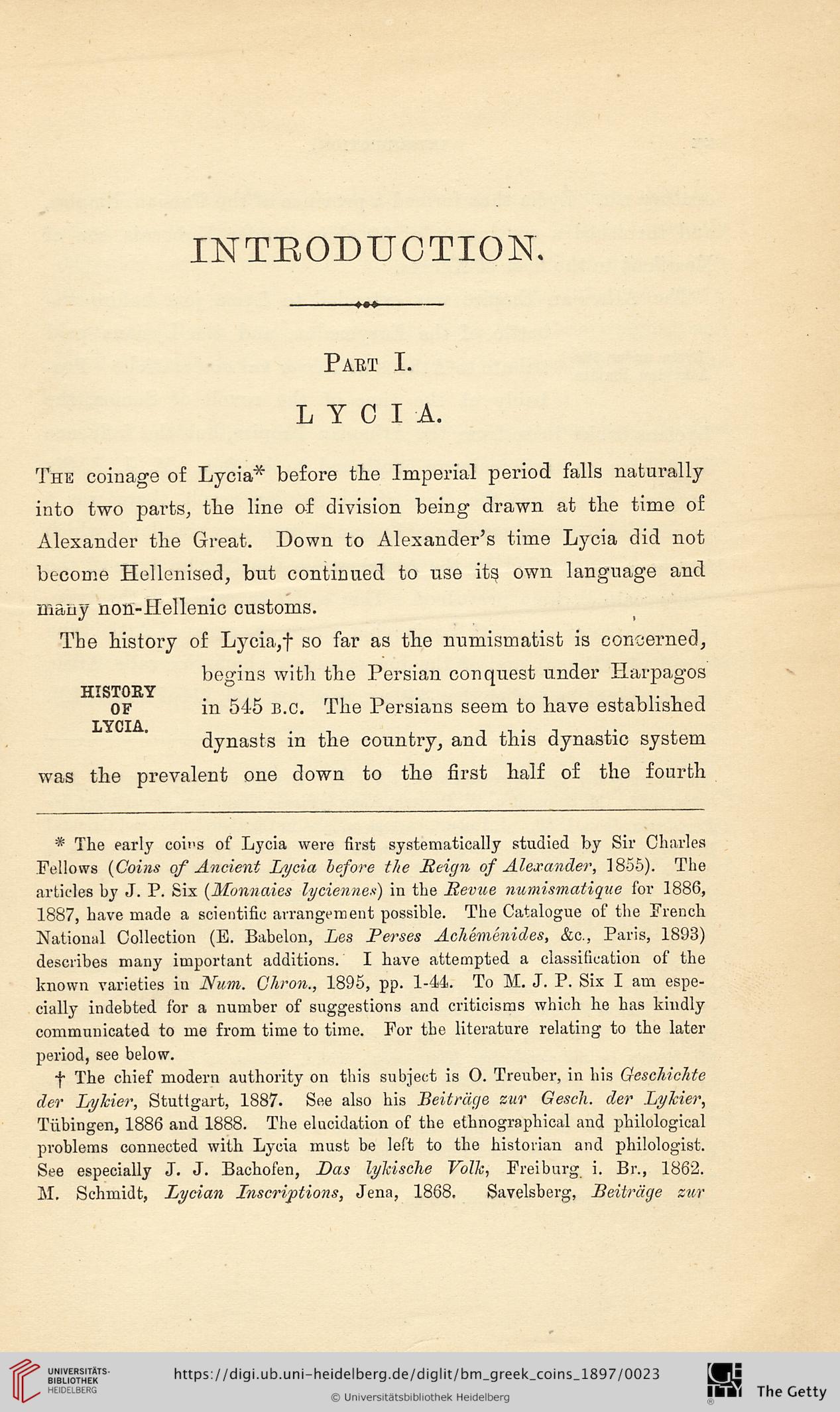INTRODUCTION.
Part I.
LYCIA.
The coinage of Lycia* before the Imperial period falls naturally
into two parts, the line of division being drawn at the time of
Alexander the Great. Down to Alexander’s time Lycia did not
become Hellenised, but continued to use it? own language and
many non-Hellenic customs.
Tbe history of Lycia,·}· so far as the numismatist is concerned,
begins with the Persian conquest under Harpagos
in 545 b.c. The Persians seem to have established
dynasts in the country, and this dynastic system
HISTORY
OF
LYCIA.
was the prevalent one down to the first half of the fourth
* The early cob's of Lycia were first systematically studied by Sir Charles
Fellows (Coins of Ancient Lycia before the Reign of Alexander, 1855). The
articles by J. P. Six (Monnaies lyciennes) in the Revue numismatique for 1886,
1887, have made a scientific arrangement possible. The Catalogue of the French
National Collection (E. Babeion, Les Perses Achemenides, &c., Paris, 1893)
describes many important additions. I have attempted a classification of the
known varieties in Num. Ghron., 1895, pp. 1-44. To M. J. P. Six I am espe-
cially indebted for a number of suggestions and criticisms which he has kindly
communicated to me from time to time. For tbe literature relating to the later
period, see below.
■f The chief modern authority on this subject is O. Treuber, in his Geschichte
der Lylcier, Stuttgart, 1887. See also his Beitrcige zur Gescli. der Lyfcier,
Tubingen, 1886 and 1888. The elucidation of the ethnographical and philological
problems connected with Lycia must be left to the historian and philologist.
See especially J. J. Bachofen, Pas lylcische Volk, Freiburg i. Br., 1862.
M. Schmidt, Lycian Inscriptions, Jena, 1868. Savelsberg, Beitrcige zur
Part I.
LYCIA.
The coinage of Lycia* before the Imperial period falls naturally
into two parts, the line of division being drawn at the time of
Alexander the Great. Down to Alexander’s time Lycia did not
become Hellenised, but continued to use it? own language and
many non-Hellenic customs.
Tbe history of Lycia,·}· so far as the numismatist is concerned,
begins with the Persian conquest under Harpagos
in 545 b.c. The Persians seem to have established
dynasts in the country, and this dynastic system
HISTORY
OF
LYCIA.
was the prevalent one down to the first half of the fourth
* The early cob's of Lycia were first systematically studied by Sir Charles
Fellows (Coins of Ancient Lycia before the Reign of Alexander, 1855). The
articles by J. P. Six (Monnaies lyciennes) in the Revue numismatique for 1886,
1887, have made a scientific arrangement possible. The Catalogue of the French
National Collection (E. Babeion, Les Perses Achemenides, &c., Paris, 1893)
describes many important additions. I have attempted a classification of the
known varieties in Num. Ghron., 1895, pp. 1-44. To M. J. P. Six I am espe-
cially indebted for a number of suggestions and criticisms which he has kindly
communicated to me from time to time. For tbe literature relating to the later
period, see below.
■f The chief modern authority on this subject is O. Treuber, in his Geschichte
der Lylcier, Stuttgart, 1887. See also his Beitrcige zur Gescli. der Lyfcier,
Tubingen, 1886 and 1888. The elucidation of the ethnographical and philological
problems connected with Lycia must be left to the historian and philologist.
See especially J. J. Bachofen, Pas lylcische Volk, Freiburg i. Br., 1862.
M. Schmidt, Lycian Inscriptions, Jena, 1868. Savelsberg, Beitrcige zur




